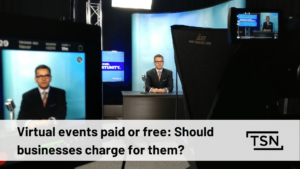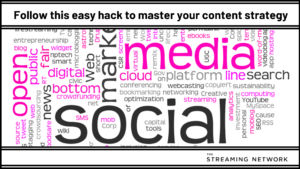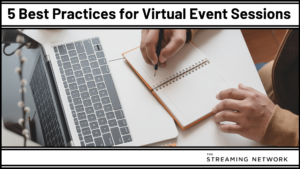Producing a webinar can be difficult, but it doesn’t have to be.
When planning a webinar for your company, it is normal to become overwhelmed by the resources and time taken to produce studio-quality content.
Some webinars can even take as much production time as a small film. This can leave companies feeling intimidated by time consumption and the detailed processes it can take when creating a webinar.
Luckily, webinar studio production is much easier than you think. With the right tools, you won’t have to stress about little details. Various audio and video equipment, platforms, strategies, and guides can make producing a quality webinar a simple and effective task.
Let’s dive into how you can make your webinar studio production easy and of the highest quality for your company and viewers.
1. Do You Have Resources Available for Webinar Studio Production?
Determining whether to begin producing your own webinar program or not, is something that most businesses need to consider.
Consider your surroundings.
Most companies may not have the space available to create a studio-quality webinar. This can be a problem, as space and location are very important aspects when filming your webinar. Due to this, many companies may become deterred from pursuing webinar production in the first place.
What resources or lead magnets you will be offering your audience?
When first starting your webinar production, it is also important to understand the genuine value of the content you are producing. Do you have all of the assets together and ready to present? Is it relevant to your audience and will it keep them engaged? Remember, producing quality webinars is key to your business and success.
Having a consistent and engaged webinar audience is a great way to capture and generate regular leads. Typically, hosting two webinars a month can attribute to a 10% growth in leads from webinar registrations.
2. Are Your Resources Engaging and Valuable to Your Audience?
While your company may have a sufficient amount of resources and assets to produce a webinar, it is important to ask yourself if the content is a good fit for your audience.
For example, hosting your content in the following formats can prove to be engaging:
- Conduct an interview with an industry leader or influencer.
- Create a panel to discuss valuable industry insights and strategies.
- Expand upon a niche strategy or industry.
- A detailed “how-to” discussion targeted towards tools and growing platforms.
Walking your webinar attendees through an informative workshop or discussion will leave them feeling valued. This will ultimately increase the chances of having them return for a second visit and become loyal viewers in the future.
Unsure of what content to put out first?
A great tip is to look into your most downloaded lead magnets. Therein lies the assets your audience clearly value and find to be relevant to them. Avoid certain content that could be best used as a press release or that can be put into a blog series. This way you can optimize your content distribution through various channels.
If you are still stressing over content, you can always talk to your sales team. They are constantly dealing with your buyer’s pain points and challenges. If they feel that the webinar content is relevant to your buyer, you are good to go.
However, there are types of content that can deter people away from your business.
The following content has been known to drive audiences away from webinars:
- Giving a direct or indirect sales pitch.
- A product release or update from your company.
- An old strategy or idea previously discussed within your industry.
Having a webinar that includes genuine and insightful information is key. If you find that you are pushing towards a sale, rather than leading a topic of discussion, you might want to consider changing direction.
Check out our Topic Mapping Template if you need help finding the right messaging for your buyers at any point during the buyer’s journey.
3. Your Webinar Studio Quality and Production Value
Producing a studio webinar with quality video, audio and content will be a strong factor in determining if your audience will return for your next webinar event.
For example, you should not be producing webinar events in your boardroom or office.
They were built to host meetings, not to record video content. You will need an open space and high-quality audio equipment to ensure your viewers can hear you clearly.
If the sound quality suffers, then your viewers will have a hard time listening to the important content you have to present. This may result in the loss of viewers. It is also a loss of your time and resources.
Think of it this way. How often do you see travellers using professional cameras to capture content?
You are more likely to find people using their smartphones to capture pictures and videos since they are equipped with amazing camera quality.
So, even if your content is relevant, it has become a global standard to curate video content with HD quality. Viewers have become used to watching content in HD and will expect the same from your business.
Here’s a quick checklist to help with the overall quality of your webinar:
- Can I interact with my viewers efficiently?
- Can my audience hear and interpret the content clearly?
- Does my webinar hold value after it has ended?
- Would I enjoy watching my own webinar?
If you do not have the technical knowledge or the resources to produce a high-quality webinar, The Streaming Network has all of the tools and resources available to create professional quality video content.
Let’s Recap:
Producing a studio webinar that is engaging, valuable and interesting towards an audience does not need to be a hassle for your business. In fact, studio webinar production can be an easy and streamlined task if you have the right tools, content, and platform.
When first producing your webinar, focus more on the content of your webinar, rather than the effectiveness of your lead generation. As you begin to master the presentation of your content and the quality of your webinar, your lead generation will begin to increase drastically.
Determining which content is appropriate to discuss during your webinar in advance is also great due diligence. Remember, your webinar should not be a blatant sales pitch. Instead, use resources and content that makes your audience feel valued and appreciated.
It is always a good idea to be a bit critical when determining appropriate content and themes for your webinar. Remember to ask your sales team if they could watch your own webinar and if it would bring any value into their professional life.
If you have hosted a few webinar programs already download our Benchmark Report. See how well you are performing against industry standards. Our report gives you all the information you need to increase viewership and grow your webinar.
Be sure to check out our latest episode of “Lessons From The Frontline”, and stay tuned for more update on webinar studio production.






